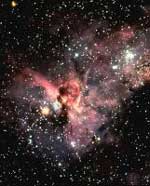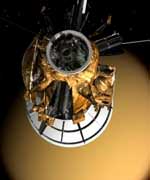
Image credit: NOAO
Monday, December 27 – No one likes to get up early, but this morning will be worth walking outside for as Mercury and Venus make a very close pairing on the horizon just before dawn. If you’re clouded out? Don’t worry. Both planets will keep their positions for several days!
With the almost full Moon rising not to long after the Sun sets, tonight let’s take the time to study another “double delight” – Gamma Arietis. Also known as Mesarthim, Gamma was one of the very first double stars to be discovered, well… rather accidentally! In 1664, Robert Hook was following a comet and stumbled upon this matched magnitude pair. At approximately 160 light years away, each of these two “white” stars are about three to four times more massive than our own Sun and are seperated by about 400 AU. Locked in an ancient embrace, the pair takes about 3,000 years to orbit each other. Since the time of their discovery, this duo’s relative orientation has remained virtually unchanged, but with the advent of modern measurement show they may have moved fractionally closer within the last 150 years. Does this mean they are drawing together? No. Like so many things we see from such a great distance, it is a matter of perspective and it is believed that we may be looking at their orbital pattern “edge-on”.
In the telescope at high power, Mesarthim is indeed a very close double, one who’s stars are precisely oriented north/south of each other. This one is quite delightful, for such similar magnitudes make them appear like “eyes” in the dark! (And if you are very, very good – you will see a tiny 9th magnitude star to the east. Fine optics and perfect stability will show this star also has a 13th magnitude companion.)
Tuesday, December 28 – Since the Moon won’t begin to rise for a short time after the skies turn dark, this would be a great opportunity to locate an easy Messier object – M34. If you remember previous study stars, Almach and Algol, you’re halfway there. Draw an imaginary line between them and look with your binoculars or finder scope just a shade north of center.
In binoculars, the M34 will show around a dozen fainter stars clustered together and perhaps a dozen more scattered around the field. Small telescopes at low power will appreciate the M34 for its resolvability and the distinctive “orange” star in the center. Larger aperture scopes will need to stay at lowest power to appreciate the 18 light year span of this 100 million year old cluster, but take the time to power up and study. You will find many challenging doubles inside!
Wednesday, December 29 – Is it gone yet? Nope. The Moon will rise a little later this evening, but we’re going to run ahead of it tonight and begin some studies in Auriga! Looking roughly like a pentagon in shape, start by identifying the brightest of these stars – Capella. Due south of it is the second brightest star, El Nath. By aiming binoculars at El Nath, go north about 1/3 the distance between the two and enjoy all the stars!
You will note two very conspicuous clusters of stars in this area, and so did Le Gentil in 1749. Binoculars will reveal the pair in the same field, as will telescopes using lowest power. The dimmest of these is the M38, and will appear vaguely cruciform in shape. At roughly 4200 light years away, larger aperture will be needed to resolve the 100 or so fainter members. About 2 1/2 degrees to the southeast you will see the much brighter M36. More easily resolved in binoculars and small scopes, this “jewel box” galactic cluster is quite young and about 100 light years closer!
There are many other fine things in this area, so scan around! We’ll be back…
Thursday, December 30 – Is it gone yet? No! The Moon will be along shortly, but not before we’ve had an opportunity to head for another northern “gem”, the M76.
Located in western Perseus just slightly less than 1 degree north/northwest of Phi, the M76 is often referred to as “The Little Dumbbell”. Originally discovered by Messier’s assistant Mechain in September of 1780, Charles didn’t get around to cataloging it for another six weeks. What a shame it took him so long to view this fine planetary nebula! Its central star is one of the hottest known, but it is its resemblance to the M27 that makes it so fascinating. Looking very much like a miniaturization of the much larger M27, the M76 is rather faint at magnitude 11, but is quite achievable in scopes of 114mm in aperture or larger. It is small, but its irregular shape makes this planetary nebula a real “class act”!
For our Southern Hemisphere friends, get thee out there and view Eta Carinae! First recorded by Halley in 1677, this nebular variable star left even the great Sir John Herschel at a loss to describe its true beauty and complexities. This “slow nova” is filled with all the wonders the we “northerners” can only dream about…
Friday, December 31 – Is it gone yet? No. The Moon will be around later tonight, but the year 2004 is just about ended. Try celebrating in a unique and inspiring way! Go observing…
In the hours before midnight, you could take a cosmic journey that spans millions of light years. In the northern hemisphere, visit with the Andromeda Galaxy again – or the Small and Large Magellanic Clouds if you live in the south. Feast your eyes on vast and wondrous displays of stars like the “Double Cluster” in Perseus, or the “Jewel Box” – Kappas Crucis star cluster. Rejoice in the birth of new stars by voyaging to the M42 – “Orion Nebula”… And remember the old by returning to the M1 – “Crab Nebula”. Take delight in the movements of our own solar system by hunting down the “Magnificent Comet Macholz”, or peeking in on Saturn’s rings. Perhaps the ISS will make a pass over your area tonight, or only a single star shine through. It may be something as spectacular as watching a meteor go down in a blaze of glory, or as quiet and contemplative as watching the Moon rise.
As we begin a New Year, just take a moment to look up at the stars and think about all the millions of years that they have been in the making and all the time that it has taken for the light to reach us. Salute!
Saturday, January 1 – Is it gone yet? No. The Moon will be on the scene later, but tonight’s goal with be a rather simple one – a star of singular beauty. Located northwest of Mu in the constellation of Lepus, is R Leporis – better known as “Hind’s Crimson Star”.
Discovered in October of 1845 by J.R. Hind, R Leporis will require optical aid to view since it is a variable that moves between approximately magnitude 6 to as low as magnitude 11 in about 432 days. As a carbon star, this particular example is well worth viewing for its intense ruby color. As R Leporis undergoes its changes, it produces amazing amounts of carbon. To understand what makes it dim, think of an oil lamp. As the carbon “soot” collects on the glass, like the star’s outer atmosphere, the light decreases until it is sloughed off and the process is repeated. At a rough distance of approximately 1500 light years, “Hind’s Crimson Star” will become an observing favorite. Enjoy!
Sunday, January 2 – Is it gone yet? No. The Moon will be around much later tonight, but the window of opportunity to view a spectacular comet is once again wide open.
Tonight the “Magnificent Comet Machholz” will be in the same field of view as 6 Tau Tauri. Having long ago achieved unaided eye brightness, C/2004 Q2 Machholz continues to delight observers the world over. The coma is easily seen in binoculars, and the twin ion and dust tails may still be observable on this date. Looking like a huge, unresolvable globular cluster, trying judging its visual magnitude for yourself by using nearby Xi and Omicron as guideposts. Defocus and compare these magnitude 4 stars to the comet’s brightness. Is the comet dimmer? Or about the same? There is no way of predicting exactly how bright comet Machholz will be in advance, but tonight you can make the call!
For very late night, or observers beginning early on the morning of January 3, keep a watch out for the annual Quadrantid meteor shower. Seeming to emanate from the constellation of Bootes, this annual shower can produce up to 60 meteors per minute, but has an unusual and unpredictable peak time. More information on the Quadrantids will be available in next week’s issue.
Until next week fellow SkyWatchers, I wish you all a peaceful and prosperous New Year. Keep looking up… I am! Light speed, ~Tammy Plotner

